Denon AVR-X2400H AV Receiver: meeting the requirements of time or more than HI-FI
I try to avoid frankly advertising in this blog. But in some cases I come across devices that I really want to write about. Relatively recently, I had the need to buy an AV receiver: I asked my brother, who prefers to watch movies at home, suffers from a mild form of audiophilia and is therefore quite critical of technology.
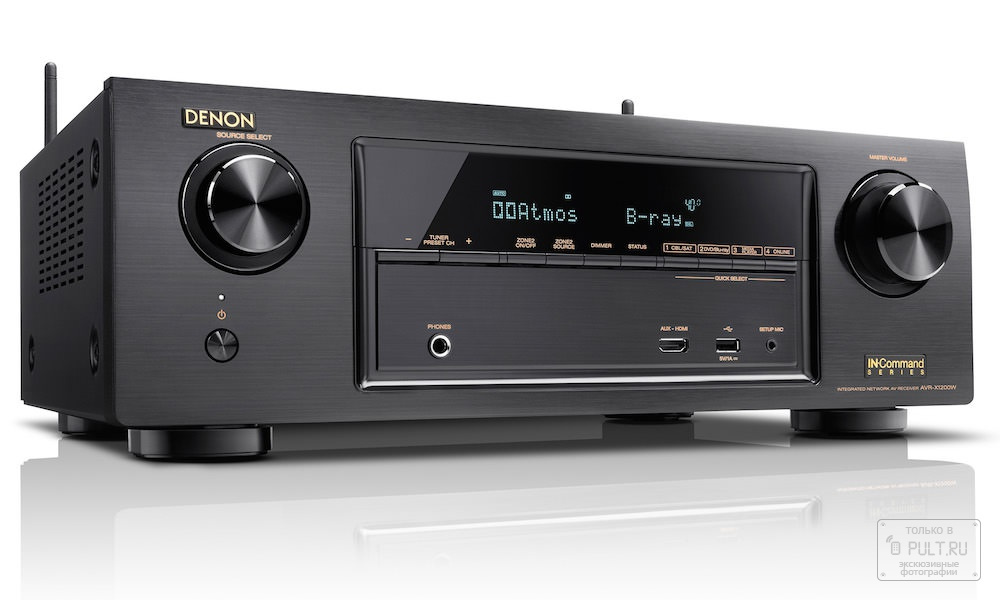
I myself have never been an ardent fan of home theaters (I prefer to visit public ones), and I came across AV-receivers solely because of my work at Pult, so the task turned out to be relatively difficult. The purchase budget was limited to 50,000 rubles, which also complicated the choice.
After two weeks of ditching and consulting with our AV specialists, I chose Denon AVR-X2400H. The device impressed me so much that I decided to do a little review. I will try to express delight without pathos, superfluous subjectivism and clogging "jeans". If you are wondering what exactly impressed me so much - welcome under the cat!
By the way, I recently published a post on how to choose AV-receivers .
The primary task was to choose a device with high sound quality, sufficient power and capabilities that fully provide multi-channel sound. Naturally, I wanted something promising in terms of using surround sound, and accordingly my choice fell on devices using progressive decoders, in particular Dolby Atmos and DTS-X - surround sound technologies that are the most promising at the moment. In addition to these relatively fresh charms, the Denon AVR-X2400H supports almost all current standards from Dolby and DXT (DTS-HD Master Audio, Dolby TrueHD, Dolby Digital, Dolby Digital Plus, etc.).
The speed of the sound iron, and, accordingly, the efficiency of the digital modes is provided by using a 300-MHz 4-core DSP processor that can operate at a speed of more than 1 billion operations per second, which is more than enough for sound processing.
The basic acoustic parameters of the receiver fully correspond to its counterparts in the price category. So the level of harmonic distortion does not exceed 0.8% (20 Hz - 20 kHz). Unfortunately, the IMD level is not indicated in the datasheet, however, judging by the subjective assessment, there are not many of them. Blind tests with similar devices that are similar in price did not reveal significant differences, which is typical for receivers with a relatively flat frequency response.
The power of the receiver (RMS) of 100 watts per channel at 8 ohms load is more than sufficient for a full sound of 50 square meters. meters For comparison, at 4 Ω load, the power (RMS) is 150 W per channel. The reproduced frequency range is far beyond the limits of human perception - from 10 - 100000 Hz with uneven frequency response between + 1 / -3 dB. According to subjective sensations, the level of IMD is also not great, which is relatively rare for this class of devices. And one more less significant, but pleasant nuance: signal-to-noise ratio of 100 dB. The above data suggests that the characteristics of the receiver far exceed the standards of the HI-FI standard.
An interesting feature of the system is the presence of a second output for the subwoofer, which is especially useful when listening to traditional stereo, and also allows you to create a more distinct low-frequency scene when using surround sound technology.
And one more thing, to apply for the purchase with the existing 5.1 system, the question arose of purchasing ceiling and other additional acoustics in order to fully utilize Dolby Atmos. We decided not to use the classic ceiling option, given the complexity of such an implementation in our conditions. We stopped at the option of installing Heco AM 200, which are installed on the backs and, due to reflection from the ceiling, imitate the emission of sound from above.
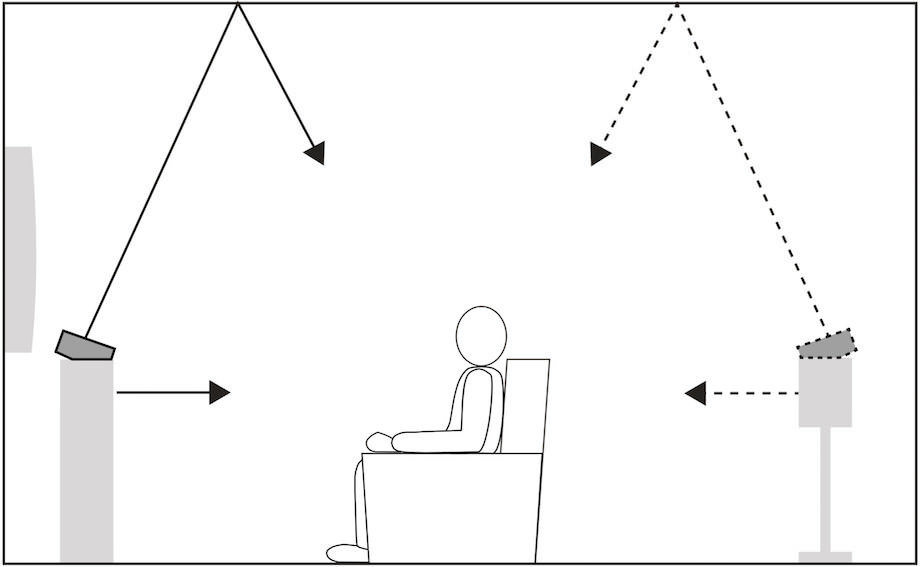
When using only 5.1 sound, it is possible to use the receiver as a simple multi-room device. The two remaining channels can be used as a stereo pair for the second room.
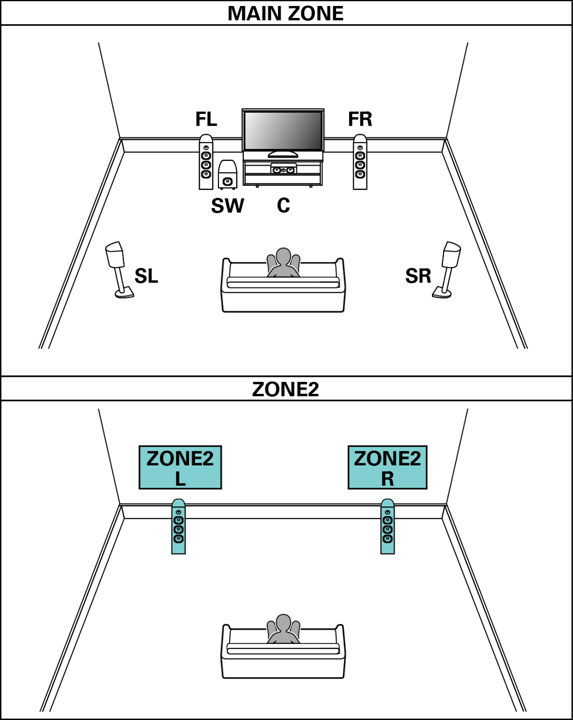
A useful feature is the use of biamping.
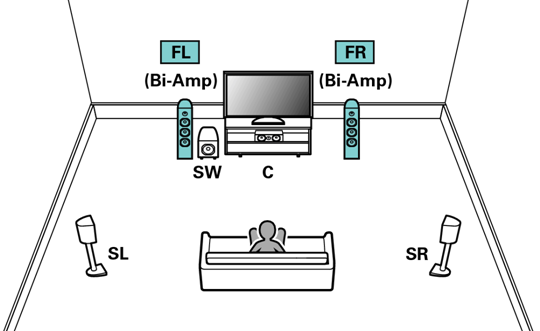
The main wireless interfaces of the AVR-X2400H are Wi-Fi and Bluetooth. For the stability of work in a given radius of reception / transmission, the manufacturer has provided two RF antennas. There is integration with AirPlay, as well as with streaming services Spotify Connect, Pandora, Sirius XM. The first was especially important, since my brother is an incorrigible brand-dependent user of Apple products.
Also implemented is receiving data stream from network storage. In other words, the receiver can act as a full-fledged network player. In addition to WI-FI, network integration can be provided via the RJ-45 Ethernet LAN port.
Mobile management is carried out using the Denon 2015 AVR Remote (Remote App) application, which is equally convenient in versions for iOS and Android. Compatibility with Mac and ES is ensured using DLNA 1.5 specifications.
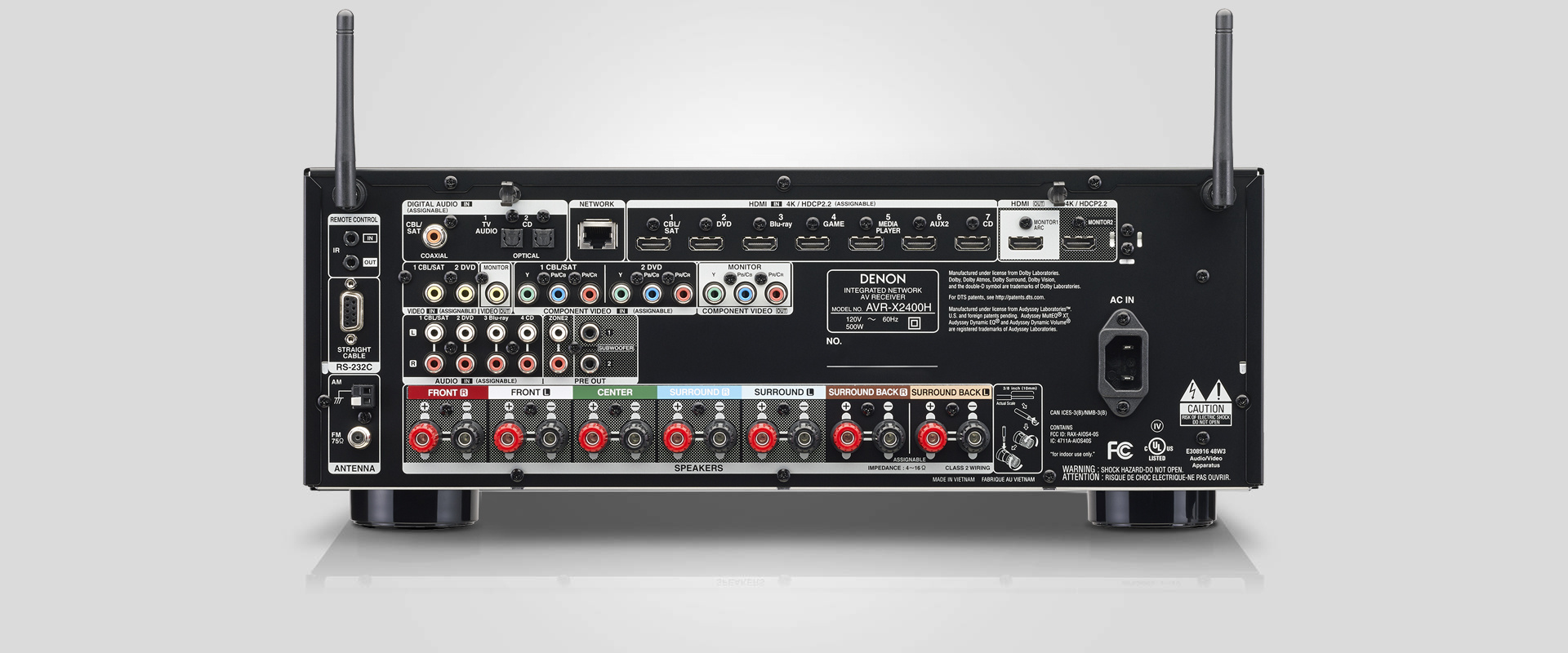
The device is equipped with eight HDMI inputs, one of which is located on the front panel, and also has two HDMI outputs. Speaking frankly, this is a bust for the conditions in which we planned to use it; four of them would be enough for our eyes. But no one knows what will happen tomorrow, and perhaps this "HDMI" abundance may someday come in handy, especially since it probably did not affect the price of the device too much. All HDMI inputs support 3D.
Personally, I am quite critical of 4K resolution, sincerely believing that Full HD is quite enough for home viewing conditions, which cannot be said about my brother. With his ultimate outlook on things, it was necessary for the receiver to support the standard BT.2020 4K Ultra HD (3840x2160, HDR, Wide Color Gamut), to “turn” into a 4K picture from good old DVDs and a TV signal. And the selected device can do it.
The graphic processor of the AVR-X2400H receiver makes it possible to process the video stream with an input / output rate of 60 frames per second (60p) and can increase the quality of the analog signal with SD definition parameters up to 4K resolution.
Denon AVR-X2400H supports all existing ISF calibration functions, as well as ISF Day and ISF Night modes. Frankly, both my brother and I didn’t care enough about the calibration capabilities, but our experts asked us to emphasize this point in the article. These functions and modes are especially important for calibration professionals who are certified to work with the ISF.
Today, many write about the fact that 50% of good sound is the acoustic treatment of a room. To some extent, Denon AVR-X2400H eliminates the need for such processing. The device uses a package of DSP audio algorithms Audyssey MultEQ XT. The task of the DSP-algorithms is to analyze the data on the room, obtained using a microphone, and on the basis of the results to carry out signal processing.
Using the MultEQ XT, the DSP processor processes the signal in such a way as to maximize the harmful effects of room acoustics and to obtain the maximum signal fidelity. The conditions in which the use of the receiver was planned were far from ideal and such a function was necessary for me.
Audyssey MultEQ XT - conducts filtering and correction of tonal balance, provides adjustment of frequency characteristics in accordance with an algorithm built on the basis of data obtained from a microphone.
Subjectively, the function works, and with its use the system forgives many flaws in the acoustic properties of the room, greatly reduces the harmful echoes of the first reflections of the MF and HF range. LF resonances cannot be completely corrected, although the overall “picture” is definitely better.
I can not say that after using Audyssey MultEQ XT, the acoustic treatment of the rooms would be completely superfluous, but the effect of this thing was really noticeable by ear and significantly increased fidelity. And most importantly, no long suffering with tuning and accurate equalization. Everything happens almost instantly.
At a cost of 45,000 rubles, this receiver was able to fully satisfy not only the basic evaluation criteria, but also the ultimatum requirements of a demanding customer. The functionality of this device is worth the money, and, perhaps, I can call this device the best in terms of price / quality / functionality.

I myself have never been an ardent fan of home theaters (I prefer to visit public ones), and I came across AV-receivers solely because of my work at Pult, so the task turned out to be relatively difficult. The purchase budget was limited to 50,000 rubles, which also complicated the choice.
After two weeks of ditching and consulting with our AV specialists, I chose Denon AVR-X2400H. The device impressed me so much that I decided to do a little review. I will try to express delight without pathos, superfluous subjectivism and clogging "jeans". If you are wondering what exactly impressed me so much - welcome under the cat!
By the way, I recently published a post on how to choose AV-receivers .
Sound capabilities
The primary task was to choose a device with high sound quality, sufficient power and capabilities that fully provide multi-channel sound. Naturally, I wanted something promising in terms of using surround sound, and accordingly my choice fell on devices using progressive decoders, in particular Dolby Atmos and DTS-X - surround sound technologies that are the most promising at the moment. In addition to these relatively fresh charms, the Denon AVR-X2400H supports almost all current standards from Dolby and DXT (DTS-HD Master Audio, Dolby TrueHD, Dolby Digital, Dolby Digital Plus, etc.).
The speed of the sound iron, and, accordingly, the efficiency of the digital modes is provided by using a 300-MHz 4-core DSP processor that can operate at a speed of more than 1 billion operations per second, which is more than enough for sound processing.
The basic acoustic parameters of the receiver fully correspond to its counterparts in the price category. So the level of harmonic distortion does not exceed 0.8% (20 Hz - 20 kHz). Unfortunately, the IMD level is not indicated in the datasheet, however, judging by the subjective assessment, there are not many of them. Blind tests with similar devices that are similar in price did not reveal significant differences, which is typical for receivers with a relatively flat frequency response.
The power of the receiver (RMS) of 100 watts per channel at 8 ohms load is more than sufficient for a full sound of 50 square meters. meters For comparison, at 4 Ω load, the power (RMS) is 150 W per channel. The reproduced frequency range is far beyond the limits of human perception - from 10 - 100000 Hz with uneven frequency response between + 1 / -3 dB. According to subjective sensations, the level of IMD is also not great, which is relatively rare for this class of devices. And one more less significant, but pleasant nuance: signal-to-noise ratio of 100 dB. The above data suggests that the characteristics of the receiver far exceed the standards of the HI-FI standard.
An interesting feature of the system is the presence of a second output for the subwoofer, which is especially useful when listening to traditional stereo, and also allows you to create a more distinct low-frequency scene when using surround sound technology.
And one more thing, to apply for the purchase with the existing 5.1 system, the question arose of purchasing ceiling and other additional acoustics in order to fully utilize Dolby Atmos. We decided not to use the classic ceiling option, given the complexity of such an implementation in our conditions. We stopped at the option of installing Heco AM 200, which are installed on the backs and, due to reflection from the ceiling, imitate the emission of sound from above.

When using only 5.1 sound, it is possible to use the receiver as a simple multi-room device. The two remaining channels can be used as a stereo pair for the second room.

A useful feature is the use of biamping.

Integration
The main wireless interfaces of the AVR-X2400H are Wi-Fi and Bluetooth. For the stability of work in a given radius of reception / transmission, the manufacturer has provided two RF antennas. There is integration with AirPlay, as well as with streaming services Spotify Connect, Pandora, Sirius XM. The first was especially important, since my brother is an incorrigible brand-dependent user of Apple products.
Also implemented is receiving data stream from network storage. In other words, the receiver can act as a full-fledged network player. In addition to WI-FI, network integration can be provided via the RJ-45 Ethernet LAN port.
Mobile management is carried out using the Denon 2015 AVR Remote (Remote App) application, which is equally convenient in versions for iOS and Android. Compatibility with Mac and ES is ensured using DLNA 1.5 specifications.

The device is equipped with eight HDMI inputs, one of which is located on the front panel, and also has two HDMI outputs. Speaking frankly, this is a bust for the conditions in which we planned to use it; four of them would be enough for our eyes. But no one knows what will happen tomorrow, and perhaps this "HDMI" abundance may someday come in handy, especially since it probably did not affect the price of the device too much. All HDMI inputs support 3D.
Video processing, adaptation, deinterlacing, calibration
Personally, I am quite critical of 4K resolution, sincerely believing that Full HD is quite enough for home viewing conditions, which cannot be said about my brother. With his ultimate outlook on things, it was necessary for the receiver to support the standard BT.2020 4K Ultra HD (3840x2160, HDR, Wide Color Gamut), to “turn” into a 4K picture from good old DVDs and a TV signal. And the selected device can do it.
The graphic processor of the AVR-X2400H receiver makes it possible to process the video stream with an input / output rate of 60 frames per second (60p) and can increase the quality of the analog signal with SD definition parameters up to 4K resolution.
Denon AVR-X2400H supports all existing ISF calibration functions, as well as ISF Day and ISF Night modes. Frankly, both my brother and I didn’t care enough about the calibration capabilities, but our experts asked us to emphasize this point in the article. These functions and modes are especially important for calibration professionals who are certified to work with the ISF.
Buy a receiver and do not repair
Today, many write about the fact that 50% of good sound is the acoustic treatment of a room. To some extent, Denon AVR-X2400H eliminates the need for such processing. The device uses a package of DSP audio algorithms Audyssey MultEQ XT. The task of the DSP-algorithms is to analyze the data on the room, obtained using a microphone, and on the basis of the results to carry out signal processing.
Using the MultEQ XT, the DSP processor processes the signal in such a way as to maximize the harmful effects of room acoustics and to obtain the maximum signal fidelity. The conditions in which the use of the receiver was planned were far from ideal and such a function was necessary for me.
Audyssey MultEQ XT - conducts filtering and correction of tonal balance, provides adjustment of frequency characteristics in accordance with an algorithm built on the basis of data obtained from a microphone.
Subjectively, the function works, and with its use the system forgives many flaws in the acoustic properties of the room, greatly reduces the harmful echoes of the first reflections of the MF and HF range. LF resonances cannot be completely corrected, although the overall “picture” is definitely better.
I can not say that after using Audyssey MultEQ XT, the acoustic treatment of the rooms would be completely superfluous, but the effect of this thing was really noticeable by ear and significantly increased fidelity. And most importantly, no long suffering with tuning and accurate equalization. Everything happens almost instantly.
Total
At a cost of 45,000 rubles, this receiver was able to fully satisfy not only the basic evaluation criteria, but also the ultimatum requirements of a demanding customer. The functionality of this device is worth the money, and, perhaps, I can call this device the best in terms of price / quality / functionality.
